Perspectives 2022
It is always fascinating to see the conviction with which many asset management professionals announce their forecasts for the year. Their predictions are often very specific, such as 'the market will go down/up in the first half of the year, with the S&P 500 falling/rising by X%, and then up/down in the second half, with the index ending the year at x%'. While it is of course possible that in any given year the prophecies of one or other of these professionals may come true, the futility of this traditional exercise of new year predictions is borne out year after year. Who could have predicted, for example, that the global equity index would end 2021 some 30% above its pre-pandemic February 2020 level?
I would say that the main questions for investors at the beginning of this year are:
- Where will inflation go?
- What will the monetary authorities do?
The problem is that it is quite simply impossible to answer these two questions. As regards inflation, the reality is that even the monetary authorities, who you would think are in the best position to predict it, and whose every statement is closely analysed by the markets, have no idea whether the rise in 2021 will prove temporary or more permanent. You only have to read the minutes of the central bank meetings in 2021 to see this. And even if we were able to predict what would happen to inflation in 2022, we would still be left with the question of how the central banks would react. In the past, there was a fairly direct link between rising inflation and monetary tightening, but more recently, the central banks have identified a number of other objectives beyond simple price stability. These include full employment, wage growth, reducing social inequality (which they themselves have helped reinforce through their policies), supporting the financial markets and even climate change. The fact remains that although investors may have some ideas or be able to envisage certain scenarios relating to these two important questions for the financial markets, they would do better to keep an open mind and avoid clinging to firm convictions.
A year ago, I wrote that rather than indulging in the traditional exercise of new year predictions, it would be better to consider the big picture and the potential implications of that picture on investment decisions. In this article, I will return to some of the points I made then and add a few more. While it is dangerous to have overly firm convictions about the direction of inflation or where the markets will go in 2022, it is still necessary, as an asset manager, to have convictions about other subjects. Here are mine:
- Generally speaking, investors have the choice between investing their money in real assets (such as shares or real estate) or in monetary assets (such as savings accounts or bonds). Behind real assets there are tangible items such as a factory or a house, while money market assets are essentially a promise made by a counterparty to repay a debt on a pre-determined date and to pay interest on it in the meantime. For both types of assets, some environments are more favourable than others. Simplifying somewhat, you could say that an environment marked by high real interest rates (interest rates well above the rate of inflation) and central banks focusing on price stability and the value of their currency is favourable to monetary assets. We are clearly not in such an environment at present. For investors wishing to protect/increase their purchasing power over time and with a sufficiently long investment horizon, real assets are clearly the better option.
Developed economy interest rates
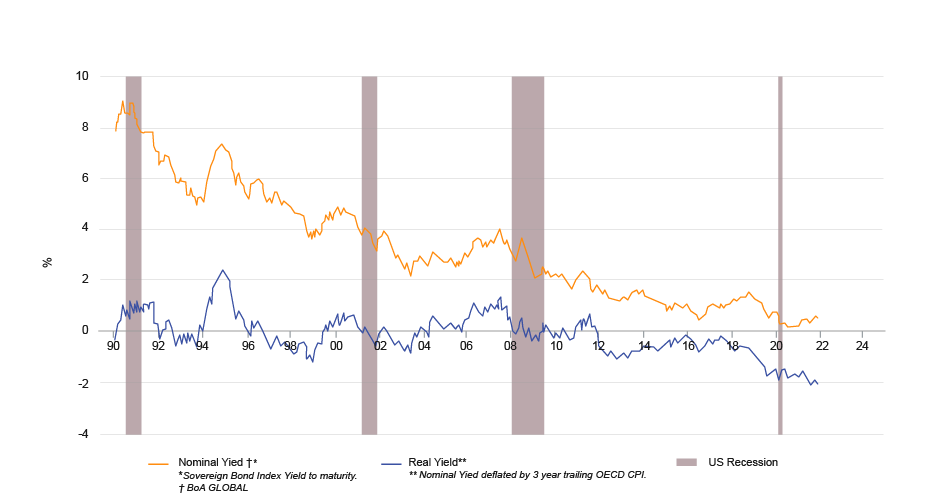
Source: Minack Advisors
- The price volatility of some real assets such as equities is generally much higher than the price volatility of monetary assets. Theoretically, the nominal value of a savings account cannot decrease, whereas the value of an equity portfolio will inevitably experience regular ups and downs (hence the need for a sufficiently long investment horizon). Higher volatility is therefore a price to pay to protect purchasing power in the current environment.
- Two factors are of crucial importance for equities: the level of interest rates and corporate earnings. The level of interest rates has a twofold importance. First, it influences the discount rate used in equity valuation models. Discounting a company's future earnings at 10% gives them a completely different present value from discounting them at 5%. All other things being equal, a decrease in the discount rate leads to an increase in valuation multiples. Secondly, the level of interest rates determines the attractiveness of equities’ main ‘rivals’: money market investments and bonds. Why take an equity risk if you can get a high return on a savings account or a bond? Interest rates and earnings were particularly favourable for equities in 2021 with interest rates remaining at exceptionally low levels and a sharp increase in corporate profits. It would be surprising if the environment continues to be so favourable in 2022.
- Equities now have high valuation multiples, often close to those recorded during the speculative bubble at the turn of the century. However, the current situation could not accurately be described as a speculative bubble. At the end of 1999, multiples were high despite relatively high interest rates (German and US 10-year rates were at 5% and 6% respectively). Today, multiples are high because of particularly low interest rates (German and US 10-year rates at -0.3% and 1.7%). In 1999, the risk premium on equities was negative, today it is close to its historical average. Back then, equities were therefore expensive in absolute and relative terms, today they are only expensive in absolute terms.
US equity risk premium
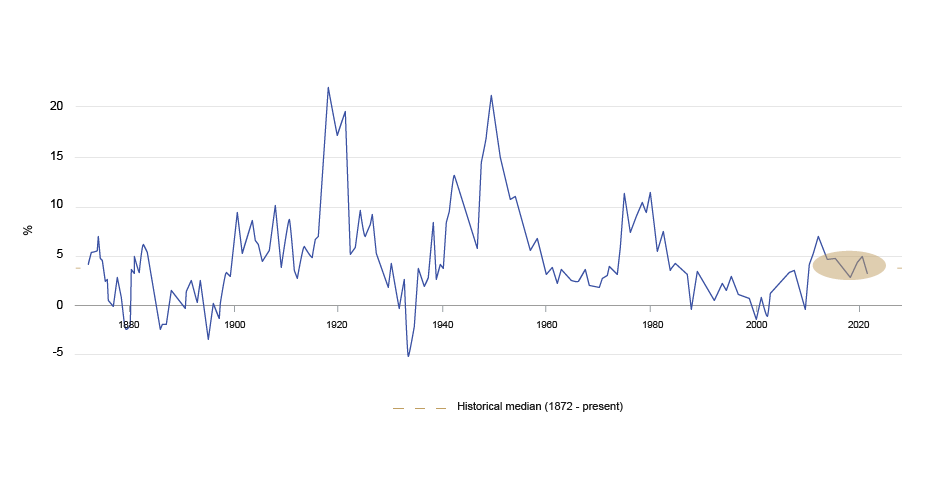
Source: BCA Research
- Nevertheless, there is a close relationship between the absolute level of valuation multiples and returns over the long term. This relationship does not exist in the short term, as an expensive market can always become even more expensive. In the long term, however, history shows that abnormally high multiples tend to gradually decrease (a process known as mean reversion). Of the three elements that determine the return on equities – earnings growth, dividend yield and multiples – the multiples will compress, which will inevitably detract from the return (the opposite being the case in periods of multiple expansion). The conclusion to be drawn from the current high multiples is therefore that expectations of future returns should be significantly lowered. This is especially true for investors who passively track the major equity indices.
- Regarding benchmarks, it is apparent nowadays that an asset manager's objectives of beating the indices and protecting the client's capital are increasingly incompatible. As long as the trend in the markets remains essentially bullish, this incompatibility can stay hidden, but if the trend were to reverse, something would have to give. In some major indices, such as the S&P 500 in the US, the weight of stocks is based on their market capitalisation. This means that the weight of stocks whose share price (and therefore market capitalisation) has already risen sharply is significantly increased and explains why in the S&P 500 index, 1% of the stocks (Amazon, Alphabet, Apple, Facebook and Microsoft) account for some 20% of the index. These five stocks have contributed hugely to the index’s performance over the last few years.
- If they can, investors should stop slavishly following the indices and instead take an active approach and consider the stock market as 'a market of stocks rather than a stock market'. The more so since the indices’ good performance last year masked the corrections suffered by a number of stocks. And correction (sometimes) means opportunity.
- Simplifying a little, we can say that on the stock market, there are companies that create long-term value for their shareholders and others that don’t. The latter are often in very cyclical sectors where good and bad years alternate, where capital requirements are high and where the cash flow generated is generally not available to shareholders but has to be reinvested in the production tool or set aside for difficult years. Companies that create value for their shareholders deserve to trade at a premium to others. To quote Warren Buffett: “It is far better to buy a wonderful company at a fair price than a fair company at a wonderful price.” Today, however, these stocks are trading at a particularly high premium. Quality stocks have been the main beneficiaries of the low interest rate environment. This makes sense: why should a cyclical company benefit from a lower discount rate on future earnings if you have no idea what those earnings will be, or even if there is a possibility that those earnings will turn into losses?
SAP and L’Oréal versus Thyssenkrupp and Orange
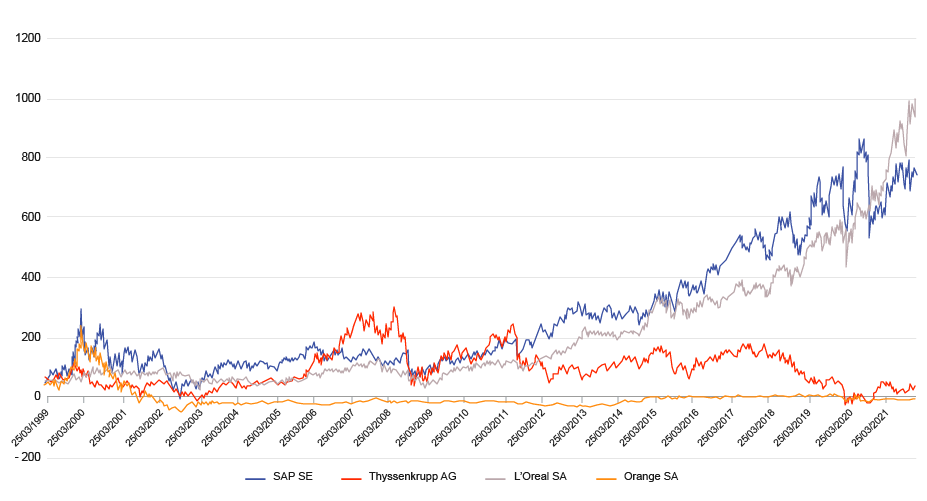
Source: Bloomberg
- So what can we do when faced with a situation where quality stocks have become expensive? A first response would be to shift from them to lower quality stocks. This is basically what many investors suggest when they recommend switching from growth to value. This kind of rotation is in fact taking place on the equity markets as 2022 gets underway, not unlike what happened between mid-2020 and the end of the first quarter of 2021. In a context of rising interest rates and high optimism about the global economy, it is quite possible that this rotation could persist. The problem with lower quality stocks is that to make money from them, you usually need very good timing: buy at the right time AND sell at the right time. But not many people manage to get the timing right and, in our view, such an approach is incompatible with our philosophy of seeing the purchase of a stock as a long-term investment in a company (many of the companies in our portfolios have been there for a very long time). A second option would be to get out of these stocks and wait for a sharp correction in their price before buying them back. If this correction comes quickly, all well and good, but if it doesn’t, the investor could be left high and dry, especially as these stocks occupy a large place in the indices.
- A third option would be to reduce the weight of these stocks in the portfolio (but not get out of them completely) in favour of other quality stocks that have risen less or have already corrected significantly (as mentioned above, many stocks have undergone major corrections in the last year despite the strong rise in the indices). Investors often tend to generalise, saying that 'equities are expensive' or 'quality stocks are trading at far too high a premium', but the reality is that equities are not a homogenous asset class.
- It is often said that the US market is very expensive, and the European market relatively cheap. However, the difference in valuation between these two markets is largely explained by the composition of the indices. The US market contains significantly more quality stocks (principally large technology stocks) which are expensive for good reason. The European market contains more value-style stocks, which look cheap. However, quality European stocks are often as (or more because there are fewer of them) expensive as their American counterparts. Generally speaking, betting on European outperformance means betting on the outperformance of the value style.
- Another fact often underestimated by investors is that the equity culture is much more deeply rooted in the US. The stock market is at the centre of the American economy. As such, it influences the decisions taken by the monetary and political authorities. Furthermore, the idea of 'shareholder value', which consists of maximising the value of assets and the return on invested capital, is much more established over there. It affects the remuneration of the leaders of listed companies and influences their behaviour. Hence, the trajectory of their company's share price is of crucial importance to them.
- That said, after some 10 years of massive outperformance, the US now accounts for almost 60% of global equity market capitalisation. Financial history shows that the winners of one decade (in the broadest sense) are rarely the winners of the next even if, at the height of their glory, the case for those winners seems compelling, as we are currently seeing for tech stocks. Examples include the 'Nifty Fifty' in the 1960s, gold in the 1970s, Japan in the 1980s, technology in the 1990s and commodities in the 2000s.
- Investors who are prepared to take a contrarian approach should consider Asia. The equity markets in this region have significantly underperformed those in Europe and the US. Once again, their underperformance is partly due to the composition of the indices, but there are also other factors including a less marked economic rebound, less monetary and fiscal stimulus (which, on the positive side, also means much lower debt and budget deficits) and the measures announced by the Chinese authorities against certain sectors and companies. Superior economic fundamentals and lower valuation multiples continue to argue in favour of the region, although it is likely to be some time before Asian markets start to outperform.
MSCI Asia ex. Japan versus MSCI World
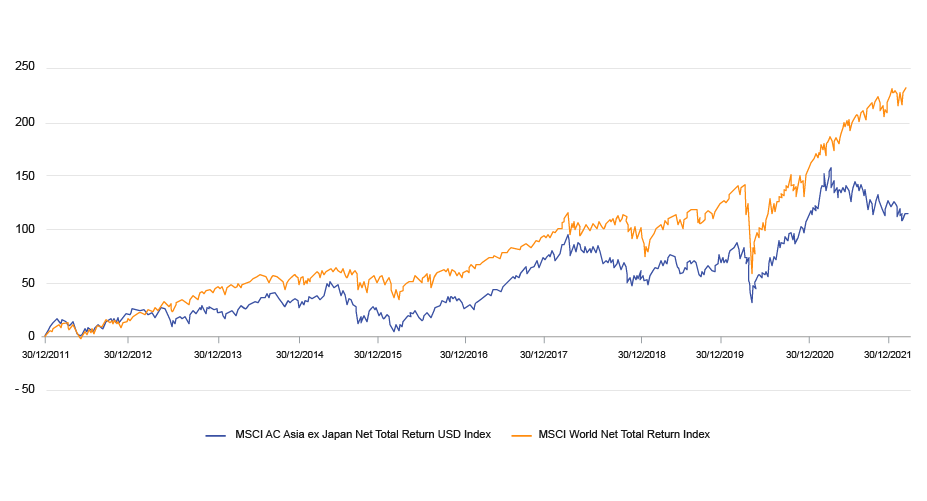
Source: Bloomberg
- Japan continues to benefit from structural elements. These include an improvement in corporate governance, the unwinding of cross-shareholdings, better capital allocation and higher returns on invested capital. At the same time, Japan has a number of high quality companies with good long-term growth prospects. Despite this, the Japanese market has still not really reappeared on the radar of foreign investors. Instead, foreign investors tend to treat Japan as a trading market, periodically injecting and withdrawing money. Their behaviour provides opportunities for asset managers, like us, who focus on company fundamentals.
% of Topix non-financials with net cash >20% of equity
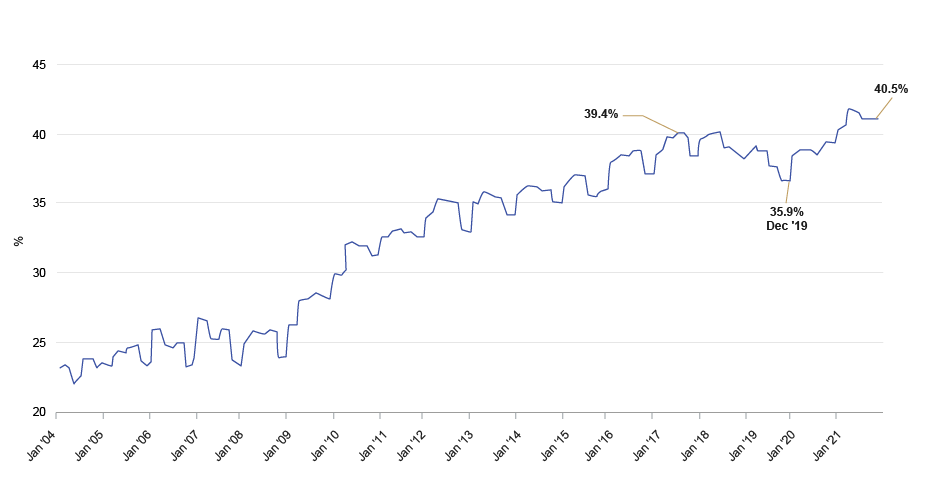
Source: CLSA
- Gold is a real asset. However, an investment in gold is and always will be speculative. This is because gold doesn’t generate a cash flow and doesn’t pay an interest. In other words, the only way for investors buying it today to make money is to find investors willing to pay more for it in the future. This is the very definition of a speculation. What is more, gold being indestructible, today's demand is tomorrow's (potential) supply. But there are market environments in which such a speculation can make sense. Since gold does not produce anything, these environments will necessarily be characterised by low or even negative real interest rates. At the same time, the monetary authorities would need to be giving the impression that the stability of their currency is no longer among their primary objectives. Both these conditions are met in the current environment, which makes gold useful in a diversified portfolio, especially as it also provides a form of insurance against geopolitical risk.
Gold and Real 10-year Treasury Yield
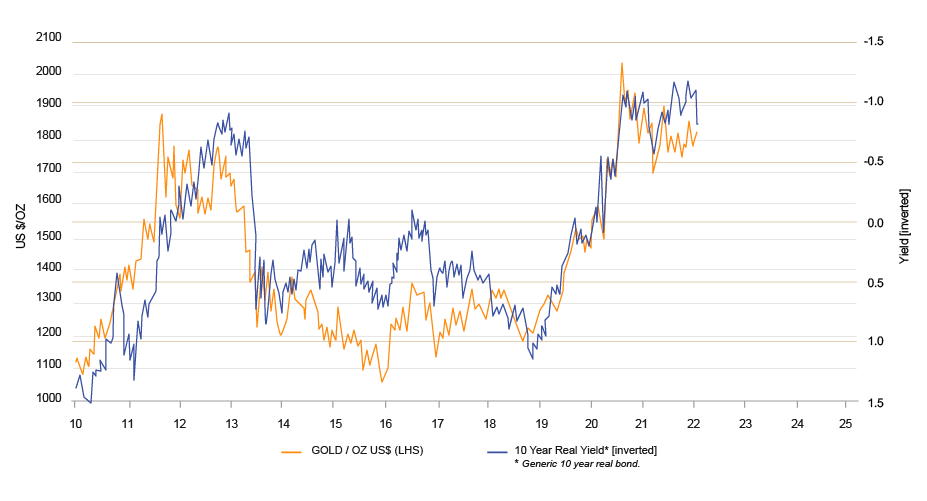
Source: Minack Advisors
- Nevertheless, gold proved disappointing for investors last year. Its price declined in a context of rising inflation and increasingly negative real interest rates. However, this performance is more logical if we start from the idea that the gold price anticipates economic developments. This being the case, the rise in the gold price of some 40% over the previous two years could be explained by the anticipation of a very negative real interest rate environment in 2021, and the relative weakness in 2021 by the anticipation of less negative real interest rates in 2022. The rise in real interest rates seen since the start of this year could continue for some time – either because inflation declines or because interest rates rise – and continue to weigh on the gold price. In other words, there are structural factors in gold's favour, but these structural factors could be temporarily masked by cyclical factors that are less favourable to gold.
- One way to invest in gold while trying to get around the problem that gold does not produce anything is through gold-mining companies. In this field, I see two particularly interesting segments. The first segment is royalty companies, which offer a far superior business model to that of conventional producers. In simple terms, this model involves financing a specific project for a producer in need of capital and in return getting a percentage of what that mine produces. Royalty companies can thus avoid a significant portion of the costs of the mining operation and generate a much higher return on capital. The second segment consists of medium-sized producers with reserves in geopolitically stable countries. These producers could become an interesting target for large producers in need of growth.
Franco Nevada (royalty company) versus Gold price and Gold Miners index
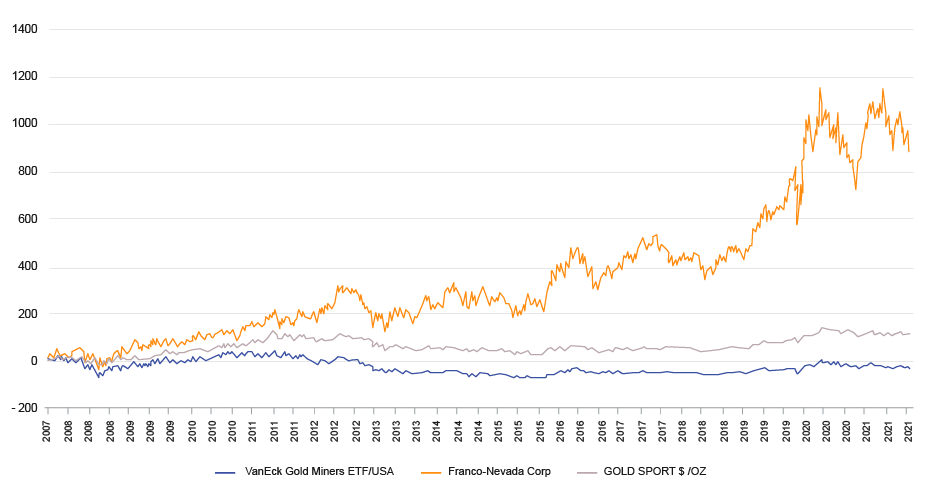
Source: Bloomberg
In conclusion, and without wishing to take part in the game of annual predictions, it would be logical to expect a much more difficult year for the markets. While it is still possible to construct a positive scenario based on a decline in inflation, sustained economic growth and wait-and-see central banks, it is clear that the current context is different from that of a year ago. Back then, inflation was just starting to rise and the monetary authorities could justify not tightening their monetary policy on the grounds that it was deemed transitory. The moment of truth has now arrived. Either inflation declines or the authorities will have to react (assuming they want to keep some credibility). This comes at a time when the capacity of the economy (and the financial markets) to support higher interest rates is uncertain – and when the geopolitical risks and uncertainties surrounding the pandemic remain all too present. This being said, there are always investment opportunities, even in a more difficult environment.
This document is issued by BLI - Banque de Luxembourg Investments (“BLI”), with the greatest of care and to the best of its knowledge and belief.
The views and opinions published in this publication are those of the authors and shall not be binding on BLI.
Financial and economic information published in this publication are communicated for information purposes only based on information known on the date of publication. Such information does not constitute investment advice, recommendation or encouragement to invest, nor shall it be interpreted as legal or tax advice. Any information should be used with the greatest caution. BLI does not give any guarantee as to the accuracy, reliability, recency or completeness of this information. BLI’s liability cannot be invoked as a result of this information or as a result of decisions that a person, whether or not a client of BLI, may take based thereon; such persons retain control over their own decisions. Interested persons must ensure that they understand the risks involved in their investment decisions and should refrain from investing until they have carefully considered, in conjunction with their own professional advisors, the appropriateness of their investments to their specific financial situation, in particular with regard to legal, tax and accounting aspects. It is reiterated that the past performance of a financial instrument is no guarantee of future returns.
Author
Guy WAGNER, Managing Director, info@bli.lu
The author of this document is employed by BLI - Banque de Luxembourg Investments, a management company licensed by the Commission de Surveillance du Secteur Financier Luxembourg (CSSF).

